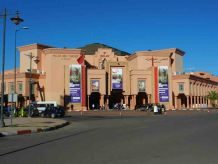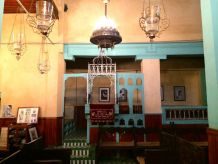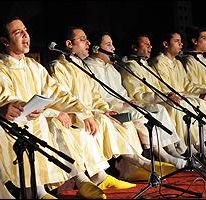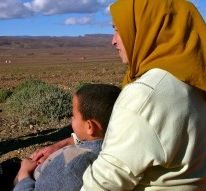Casablanca, the largest city in Morocco and one of the most important financial centers in Africa, is often referred to as Morocco’s urban jungle. This chief port city has a population of 3.35 million people. Casablanca is a melting pot of cultures with a multilayered history. The 21st-century Casablanca is a unique assemblage of cultures and influences. The city is constantly in a state of growth and home to a rich art scene, vibrant nightlife, and a vast network of underground art. One could easily spend a few days exploring Casablanca’s multitude of neighborhoods, architecture, design boutiques, restaurants, and nightlife. If you plan on visiting Casablanca by cruise ship, on a private Morocco tour or during an airport layover, and have only 24 Hours in Casablanca, there’s a wealth of things to see and do that will bring you into the beating pulse of the city.
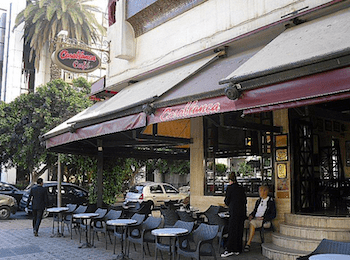
24 Hours in Casablanca, Morocco’s Urban Jungle
Breakfast & People Watching on Mohammed Blvd – 9:00 a.m.
Casablanca is large and very spreadout. Unlike Morocco’s smaller Imperial Cities, it is not possible to walk the entire city in one day. The best plan to see the city is in 24 hours is to either combine walking with public transportation or consider a Casablanca private tour. Taxis in Casablanca are inexpensive (approximately 20 Moroccan dirhams or $2.00 USA dollars for a 10 minute ride.) Casablanca also has a well organized tram system which covers a 19-mile distance around the main parts of the city. You may start your morning sipping coffee with breakfast and people watching at the historic Cafe France on Boulevard Mohammed V. Boulevard Mohammed V is a wide avenue built in 1915 and the oldest in Casablanca. One side the boulevard is is dotted with several well preserved Art Deco buildings and the opposite side has an arcade filled with booksellers, coffee roasters, and merchant stalls. Next door to Cafe France is Place des Nations Unies Square, where the main market of Anfa once resided. During summer, the plaza hosts the Jazzablanca Festival, a free annual jazz event.
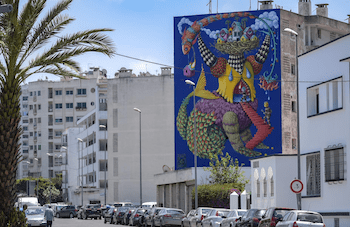
Explore Street Art in Morocco – 11:00 a.m.
After breakfast, explore Casablanca’s underground art scene by walking the Sbagha Bagha graffiti route. Sbagha Bagha is a Casablanca cultural arts and street festival founded in 2013. The city is famous for its street photography scene and street art frescoes that adorn its buildings. To celebrate Casablanca’s young talent, Sbagha Bagha hosted its second graffiti battle in 2018. For 3 days, 12 selected Moroccan artists, and several international painters competed in front of a live audience for the champion graffiti crown. The competition was to reinterpret the animal world and reintegrate it into Casablanca’s concrete city walls. The street art murals are permanent and can be seen year-round.
The next stop for exploring street art will take you past the ancient medina’s walls, to Boulevard de Tiznit and the Corniche which wraps around Casablanca’s Grande, Hassan II Mosque. This street features Moroccan artist Ed Oner’s art wall. Further along, on Boulevard de Bordeaux and Rue Ibn Assabadeh you will find the art made by Mexican-American Artist Werc and pieces from the Flemish artist Roa. There is also a wall that displays Canadian artist Danae, near Rue d’Indochine Pest, an artist from the French underground movement has left his mark. Other neighborhoods where you can discover street artwork are Roches Noires, Sidi Moumen, Sidi Bernoussi, Technopark, and Sidi Maarouf.
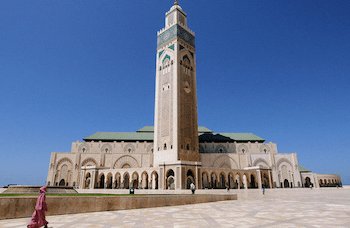
Lunch & Marvel At The Tallest Mosque in Africa – 1:00 p.m.
Completed in 1993, The Hassan II Mosque is well appointed along the edge of Casablanca’s Corniche, close to the Sbagha Bagha graffiti route. Travelers from around the world travel to see The Hassan II Mosque for its minaret which stands at 210 meters. The Hassan II Mosque’s minaret is the tallest in Africa and the mosque cost nearly $700 million dollars to complete. This Grande Mosque is a sacred place of worship for Moroccans and a symbol of the country’s artisan talent. Craftsmen were chosen, by committee, from all over Morocco to hand carve 53,000 meters of wood and 10,000 meters of ceramic zellige tile for the elaborate structure. The mosque is built into the sea, covers 9 hectares, and includes a library, museum, and madrasa (Koranic school) showcasing Islamic architectural design. Elements like arabesques, muqarnas, coffered ceilings, fountains, and a multitude of geometric patterns ordain this grand elegant structure.
After visiting the Hassan II Mosque, consider lunch at Le Great Gatsby Cafe & Restaurant, located directly across from the street. Le Great Gatsby offers an excellent international lunch menu and assorted dessert selection. Also nearby is Rick’s Cafe, founded by American expat Kathy Kriger and designed to recreate the bar made famous by Humphrey Bogart and Ingrid Bergman in the movie classic Casablanca
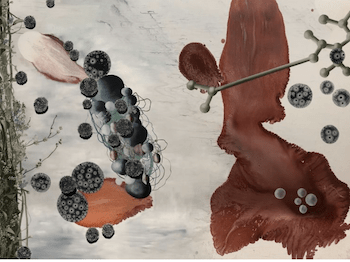
Modern Art Casablanca – 3:00 p.m.
For a richer understanding of Morocco’s contemporary art scene, visit Gallery L’Atlier 21. This prominent gallery exhibits and sells work of established Moroccan artists like Hassan Hajjaj, Nabil El Makhloufi, Mohamed El Baz, and Najia Mehadji. L’Atelier 21 was one of the 18 leading galleries to exhibit work at the second edition of the 1-54 Contemporary African Art Fair. Open 7 days a week except during lunchtime. 21 Rue Abou Al Mahassine Royani, Casablanca
Discover Jewish Heritage in Casablanca – 4:00 p.m.
A melting pot of cultures, Casablanca has a Jewish heritage worth exploring during your 24 hours journey. The city boasts over 30 synagogues with Temple Beth-El being the most famous; it is at the center of the former vibrant Jewish community. Refurbished in 1997, Temple Beth-El has magnificent stained glass windows, towering chandeliers and architectural highlights made of white and gilded plaster. The synagogue offers insight into how Islamic geometric design has permeated Jewish architecture. One of the synagogue’s main entrances is adorned with a geometric pattern of the Star of David; the walls and ceilings feature elaborate designs reminiscent of arabesque, and the outside courtyard has a fountain (typically found in mosques for washing before prayer).
École des Beaux-Arts of Casablanca – 5:00 p.m.
A significant landmark in Morocco’s history of modernism is the École des Beaux-Arts of Casablanca. Casablanca rebelled against its French roots in easel painting and focused on highlighting Morocco’s visual culture and architecture. The Casablanca School of Art is sometimes compared with its art peer, The Institut National des Beaux-Arts in Tétouan, however, Casablanca’s school is municipal. The school has been linked with Melehi Mohammed, Morocco’s modern art master, and Farid Belkahia, who was also relevant in the modern art movement and the school’s second director. École des Beaux-Arts is conveniently located between the Cathédrale Sacré Coeur and Grand Théâtre De Casablanca, and open year-round for visitors.
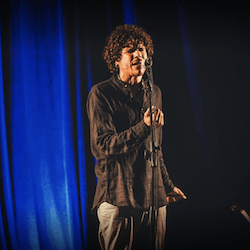
Casablanca Nightlife – 7:00 p.m.
The nightlife in Casablanca vibrates with everything from elegant soirees, to live jazz sessions, opera evenings, and art gallery affairs. To experience Casablanca nightlife start with the Instituto Cervantes or the French Cultural Center. Both venues rotate between jazz sessions, art openings, book readings, and host cultural evenings with traditional Gnawa musicians. Another nightlife option is the Boultek Center located in Technopark Casablanca. The Boultek Center, the first in Morocco, is dedicated to contemporary musicians and was created as a workspace for professional performance. Each month the L’Eac – L’Boulevart association, who works with Casablanca Technopark, organize concerts and other artistic events to enhance art and culture offerings in Morocco’s economic capital.
Another nightlife option is a sunset cocktail paired with the best views of the city at Sky 28, located on the top floor of the Kenzi Tower Hotel.
Interesting Facts: Exploring the History of Casablanca, Morocco’s Urban Jungle
The bustling city of Casablanca has a rich underlying history of authenticity and colonialism which has made it what it is today.
Casablanca’s has been redefined over the last century. In the seventh century, Casablanca was referred to Anfa given it was settled by the Berbers, and later when the Portuguese took control in the 16th century, then referred to as Casa Branca. This white city was even briefly under Spanish control when Portugal succeeded it’s crown to Spain.
In 1755, when Casablanca experienced the aftermath of the Lisbon Earthquake, Sultan Mohammed ben Abdallah rebuilt the city, naming it Dār al-Bayḍā; and until Casablanca gained independence from France in 1956, the metropolis was ruled under the French Protectorate and European Christians.
The Jewish population also left its mark on Casablanca; a Sephardic community existed in Anfa until 1468, and then returned when Rabbi Ellijah built Casablanca’s first synagogue.

